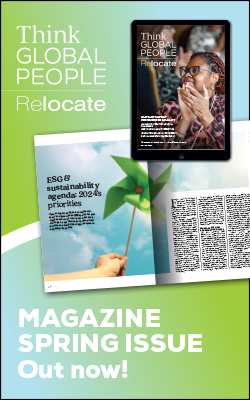Artificial Intelligence the impact on the global mobility function
Artificial intelligence (AI) has become headline news with media stories suggesting that it could potentially take over from human beings, even writing us out of the picture completely. So what does AI mean for the global mobility function? Dr Sue Shortland reports on recent AIRINC research into the role of AI and other technological advancements.
This article is taken from the Autumn 2023 issue of
Think Global People magazine
Click on the cover to access the digital edition.The global mobility function has always relied upon the use of technology. As global mobility increases post-pandemic, and the types of policies in place to support it become more numerous and complex, so the pressure increases upon global mobility professionals to leverage technology to an even greater extent to make their programmes more efficient and effective.The workload of global mobility professionals is increasing day-by-day as the numbers of policy types being used continue to rise, their complexity increases, the demand for flexibility in policy application increases, and additional aspects of employment are added into the function’s remit. These include managing employees who wish to work from anywhere/remotely. In addition, global mobility has to respond to a widened customer base including the line, the business, and a greater diversity of employee and family clients.The external context is also becoming more complicated given inflation, economic problems, global political instability, and the increasing demand for top talent. Added together, these factors result in the global mobility professional relying to a far greater degree on technology, particularly automation and the use of application programming interfaces (APIs), than in the past.Indeed, recent research from Mercer indicates that 69% of HR professionals plan to increase investment in digital platforms to support benefit administration and communications within the next three years while 89% of those with such technology already in place claim it supports greater agility. But this raises the question of where AI fits in.
Related reading from Relocate Global
- Scientists' delight as UK rejoins Horizon
- Changing skills needs pose growing challenge
- The drive for companies to become more entrepreneurially focussed in the new world of work
How AI fits in
Artificial intelligence (AI) is not new, but it has become headline news in recent months generating considerable hype and hysteria. As attention-grabbing technology, it has the potential to improve various aspects of the global mobility function’s work and speed up and improve the international relocation process.But first of all, it is important to understand the difference between AI and other forms of technology. AIRINC defines AI as “an intelligent computer that can learn and act autonomously in order to perform tasks normally requiring human intelligence”. It is important to distinguish this from APIs. Here again, it’s useful to draw on AIRINC’s definition of an API as being: “a way for computer systems to talk to each other…one user interface…that takes advantage of multiple computer platforms”. As such, APIs comprise software ecosystems. AI and APIs need to be distinguished from automation, which refers to “the use of technology and software to automate repetitive and manual tasks, reducing the need for human intervention and increasing efficiency”. Automation can make use of both AI and APIs, with the process speeding up repetitive tasks through improved system workflows.AI is, in effect, a computer that is trained to think like a human being. We have had experience of chatbots for some years. However, chatbots tend to be quite basic in their ability as they are designed currently to provide pre-defined answers to frequently asked questions. AI in the form of virtual assistants can potentially improve the accuracy of responses as they learn and are more able to provide tailored answers rather than predefined responses.AIRINC’s recent benchmark survey* suggests that over 70% of organisations currently do not use AI at all within their global mobility programme but it suggests that, in the future, this will fall to less than 10%. Over half of the participants envisage AI being used either to a moderate degree or to an extensive degree going forward. Turning to where AI might be employed, respondents noted that it is most likely to be used within routine tasks including preparation of balance sheets, payroll statements, updating policies, and tax and immigration reporting and compliance. Potentially though, respondents see greater input from automation within these tasks and the use of linked API ecosystems although the role of AI within these is likely to increase.Interestingly, the AIRINC survey respondents report it less likely that AI will benefit relationship-based work – namely how the global mobility function operates in terms of its personal interactions with employees and the business. In essence, greater input into the strategic function, including talent strategy, international staffing and assignment planning, is seen as remaining a human preserve rather than falling within the domain of AI.Communication and relationship building are considered to be important human activities, particularly as they involve empathy and trust. Nonetheless, AI is thought to help enable the employee experience by speeding up effective communication and supporting flexibility in choice of benefits.AI’s future benefits
In terms of how mobility will be impacted in the future, AIRINC suggests that tasks are likely to be streamlined to a greater extent such that process approval is required for fewer steps within the mobility process. Improved chat functions will speed up the delivery of interventions and services from vendors can be brought to market faster.To reduce environmental impact and again speed up the relocation process, destination service providers might use AI to change the way home and school search is conducted. The use of virtual reality headsets can provide a personalised home search service and children will be able to sit within virtual classes in schools. Such AI interventions could reduce costs as well in terms of negating the need for personal home/school search visits abroad.In summary, positive aspects of AI include freeing up global mobility professionals to focus more on strategic issues such that less of their time is spent on routine process tasks and on repetitive functions. A combination of increased automation and API ecosystems use supported by AI technology could potentially result in a reduction in the routine workloads of the global mobility function enabling it to focus more carefully on a strategic role. It could also improve the employee experience and help to reduce physical relocation costs.Benefits versus drawbacks
While the future for the use of AI might appear bright, AIRINC does raise some warnings: the downside of AI must also be considered within global mobility. The first point concerns quality. AI systems are designed to learn from the inputs they receive and the old adage of “rubbish in, rubbish out”, applies. Not all materials on the internet from which information can be drawn are accurate, for instance. The data that is uploaded by global mobility professionals will be incorporated by AI systems and so it is important to ensure that any uploads are accurate and do not contain confidential/sensitive material.The next point concerns control of materials; the sources used may be dubious or plagiarised. It is important to be sure of the sources from which materials are being drawn because otherwise data being supplied to individuals through AI systems in terms of answering their questions may be inaccurate.A further point raised by AIRINC concerns the cost of developing or customising AI tools. Complex mobility programmes may require considerable investment in order to ensure AI systems being used either directly or as input into APIs and automation are doing their job correctly. Human input is therefore still likely to be necessary to ensure that AI technology does not give incorrect answers or lead policy design into an unwelcome direction.The future lies in global mobility upskilling
Consideration also needs to be given to the effect on global mobility professionals’ employment prospects. It is impossible to predict the future, but there is bound to be concern over whether AI will eventually take over the job roles of global mobility and other service firm professionals. Indeed, when asking their survey participants this question, AIRINC certainly found there was concern amongst those working in the industry as to the negative effects of AI on the job market.The conclusion though was that despite any uneasiness over employment opportunities within the global mobility function, it is not possible to take an ostrich-like approach and bury one’s head in the sand. Upskilling will be required such that the function keeps on top of new developments and uses AI, APIs and automation to its advantage going forward into the future.Read more global mobility news in the upcoming Autumn issue of Think Global People magazine. Reserve your copy here.
Find out more about the Think Global People community.
Subscribe to Relocate Extra, our monthly newsletter, to get all the latest international assignments and global mobility news.Relocate’s new Global Mobility Toolkit provides free information, practical advice and support for HR, global mobility managers and global teams operating overseas.
©2024 Re:locate magazine, published by Profile Locations, Spray Hill, Hastings Road, Lamberhurst, Kent TN3 8JB. All rights reserved. This publication (or any part thereof) may not be reproduced in any form without the prior written permission of Profile Locations. Profile Locations accepts no liability for the accuracy of the contents or any opinions expressed herein.































